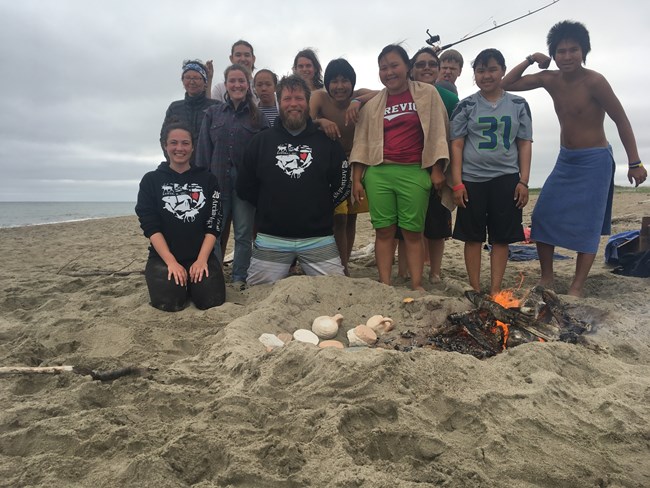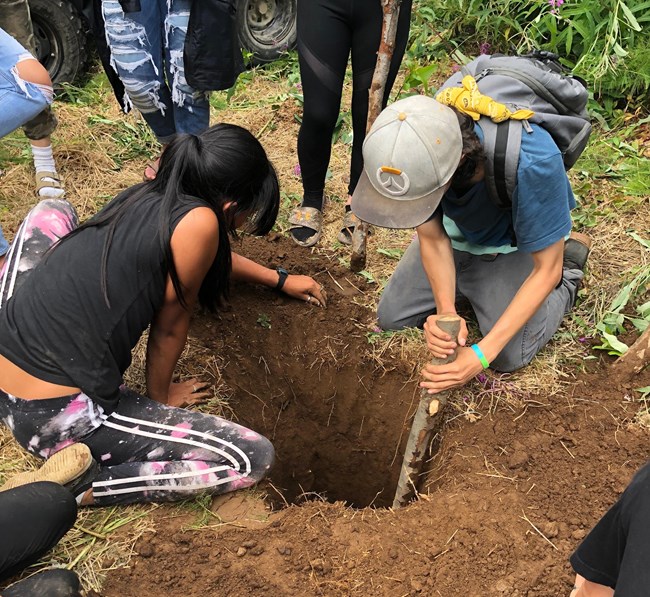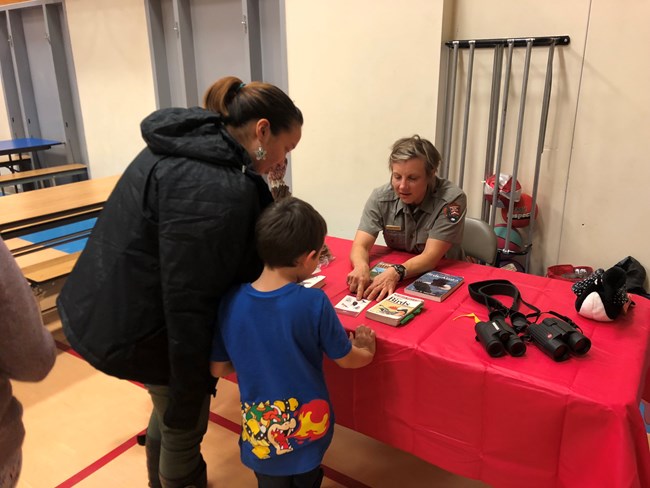Last updated: November 29, 2019
Article
2019 Science Education Grants
The Murie Science and Learning Center (MSLC) in Denali National Park and Preserve funds numerous outreach projects through the Science Education Grant program. These grants help MSLC partner parks pay for science education outreach projects. Funding for the Science Education Grant program is provided by Alaska Geographic.

USFS photo
Anchorage Outdoor School
Anchorage Outdoor School brought 32 fifth grade students from Creekside Park Elementary School, a Title 1 school, to Portage Valley, Alaska, to study science, health, and physical education. During three days of exciting, hands-on activities, students collected and studied macro invertebrates, used increment borers to age trees, observed glacier features, recorded soundscapes, learned moose calls, built fires, made s’mores, and picked up over 30 pounds of litter! Students were evaluated before and after the program and were able to recall many new ecology terms like “food chain,” “decomposers,” “fungus,” and “invertebrates,” showing an expanded understanding of their natural environment. This was the first test of the Anchorage Outdoor School program, a collaborative effort to cultivate the next generation of stewards for public lands in Alaska. The National Park Service, in partnership with six other agencies, will continue fostering stewardship and citizen science among young Alaskans in the Anchorage School District via this program in fall 2019.

Photo courtesy of Nick Treinen, Katirvik Cultural Center
Nome Archaeology Camp
The 5th annual Bering Strait Archaeology Camp, held this July in Solomon with students from Koyuk, Nome, Brevig Mission, and Stebbins, is a partnership between Kawerak, the National Park Service, and Alaska Geographic. Offered for credit through UAF Northwest Campus, it teaches students to combine archaeological methods like surveying house pit sites, analyzing artifacts, and interviewing elders to create a picture of the past. Students and instructors constructed a replica kazghi (men’s or community house) based on information learn through the camp and oral histories. Making naniit (clay seal oil lamps) was a favorite activity of both the students and the instructors.

NPS Photo
Writing in the Woods Camp in Fairbanks
A 2019 Science Education Grant from Alaska Geographic and Denali National Park and Preserve allowed the Fairbanks Alaska Public Lands Information Center (FAPLIC) to implement a successful nature journaling camp, Writing in the Woods, for a third consecutive year. The camp, which integrated art, writing, and science content with outdoor exploration, safety, and stewardship activities, took place from August 5-9. It was offered free of charge for rising 3rd-7th graders from the Fairbanks, Alaska metropolitan area.
During field trips to a variety of Fairbanks-area locations participants learned about natural history of interior Alaska, gained confidence in the outdoors through short hikes, and honed personal and academic skills and abilities including observation, questioning, measuring, scientific illustration, recording detailed written information, personal reflection, and creative writing.

NPS Photo
Lake Clark’s Village Day Camp Program
This summer more than 100 kids from Nondalton, Newhalen, Iliamna, and Igiugig participated in Lake Clark’s fifth annual Village Day Camp program. Preschool and elementary age participants played games, did crafts, and participated in observation-based investigations inspired by park resources. Middle and high school age participants worked with archeologist Monty Rogers to learn traditional Dena’ina and Yupik techniques for building in-ground food caches. Using the techniques they learned, participants then dug and built actual cache pits. As part of the workshop, illustrator Kristin Link provided a scientific illustration lesson based on in-ground caches, where students learned linear perspective and scientific illustration techniques. Through a grant-funded partnership between the Lake and Peninsula School District and the village of Igiugig, called Communities Teaching Culture, kids were able to get school credit for participating in this standards based workshop.

Photo courtesy of Stacy Golden, Sitka High School
Science Field School in Sitka National Historical Park
In partnership with the Sitka Sound Science Center, Sitka National Historical Park conducted its second annual Field Science School Program! A dedicated group of ten high school students successfully completed our ten-week summer program. Field Science School was designed to provide hands-on, real world experience to students interested in science and being outside. Each week we partnered with different agencies and organizations to give students a broad perspective on the field projects happening in Sitka. Students were able to travel to Kruzof Island to conduct marine debris surveys, monitor for harmful algal blooms, receive marine safety training, and learn about landslide science from the U.S. Forest Service, plus many other topics! Participants walked away with a deeper understanding of the research happening in their community, learned about the types of outdoor work they could get paid to do, and connected with students who had similar interests at adjacent high schools.

NPS Photo
Kotzebue Summer Science Camp and Interpretive Programs
For the 11th consecutive summer, Western Arctic Parklands offered Camp Willow to local Alaska Native youth, ages 10-15. During the camp, students participated in activities teaching them what it takes to be a field biologist. Kids traipsed through the tundra using GPS to guide their journey and picking ripe tundra berries along the way. Once camp was set up, students enjoyed learning how researchers study voles. Additionally, the park was able to offer community programs each week including films, workshops, demonstrations, research presentations, and weekly kids programs. These activities are a staple NPS offering in Kotzebue and cumulatively served over 1,500 participants.

Photo courtesy of Wrangell Institute for Science and Environment
Environmental Education Internship in Alaska’s Copper River Valley
Wrangell Institute for Science and Environment (WISE) hosted Mary Hannah Giddons, a recent graduate of Sewanee, College of the South, as our Stewardship and Environmental Education Intern. She was with WISE from mid-May until Mid-August, participating in a wide variety of programs. Mary Hannah’s enthusiasm and curiosity was an inspiration for our youth participants. Her passion is geology, so she took the lead on instruction for our Geology Camp. She travelled with Copper River Stewardship Program as a chaperone and instructor, including mentoring the students as they developed their final projects.
Photo courtesy of Wrangell Institute for Science and Environment
Science Camps in Wrangell-St. Elias National Park
Wrangell Institute for Science and Environment hosted two science camps in Wrangell-St. Elias National Park this summer. Our Aquatic Ecology Camp was held at Silver Lake, and gave 12 youth ages 10 to 14 a chance to explore all things wet, muddy, and fishy. A highlight was the chance to conduct experiments on the “Stream Table” hydrology simulator, which mimics the processes of erosion and deposition in moving water. The students also dredged the lake bottom for macroinvertebrates, set traps for juvenile fish, and learned how to safely recover from a swamped canoe. For Geology Camp, we hiked to Bonanza Mine in Wrangell-St. Elias National Park and filled our pockets with beautiful rocks as we learned about how copper is formed and how glaciers sculpt the landscape.

NPS Photo / Melanie Flamme
Science and Friendship in Circle, Alaska
In fall of 2019, National Park Service (NPS) staff in various career fields, along with our partner, Media Change Agent, held a career and science blitz at Circle School. Since 1975, Circle has been the launch site for Yukon-Charley Rivers National Preserve’s annual long-term American Peregrine Falcon surveys. Many other NPS studies also occur in the preserve including shallow lakes monitoring and archaeology, bird, moose, wolf, and botanical surveys. Our goals were to provide information about career and internship opportunities for youth and community members, and to engage everyone in Alaska park science! The day-long event included career training and science programs in the classrooms. After school we set up several scintillating science stations and students blitzed on owl pellet dissection, archaeological digging, bird identification, aerial photo caribou counting, videography, and small mammal trapping. To encourage students to pursue science we also featured a science fair station and shared about NPS career fields. Through these activities we hope that we have increased awareness of NPS career fields and Alaska park science and strengthened our friendship with the community of Circle, Alaska.

NPS Photo / Melanie Flamme
Engaging Students in Laboratory Research and Science
This summer, six interns joined the U.S. Fish and Wildlife Service environmental contaminants lab to address emerging conservation questions involving Red-throated Loons. In summer, these little loons breed along coastal areas of Alaska and winter in nearshore areas of Alaska, Russia, and Asia. Concern for this species is mounting as recent evidence suggests increased exposure to several environmental contaminants. Red-throated Loons may be exposed to toxins from industrial effluent when foraging in nearshore marine environments. In addition, Alaskan waterbirds and their eggs may be harvested as subsistence foods by rural and Native Alaskans, creating a concern for human health.
Our environmental interns received on-the-job training and wrestled with this developing dilemma in the laboratory. Mentored by previous interns and experts from U.S. Fish and Wildlife Service Environmental Contaminants Program and National Park Service, they processed bird eggs and mammal hair samples, created a poster, and presented their experiences at the Alaska Bird Conference and the Alaska Forum on the Environment meetings. Through this internship, these young professionals developed into next-generation scientists and highlighted an emerging resource management issue in species of concern.

NPS Photo / Melanie Flamme
Video Storytelling at Effie Kokrine School
Young people have science stories to tell, but without training they lack the technical knowhow to effectively share this knowledge in the modern digital era. In order to help youth gain these skills, Wildlife Conservation Society (WCS), Alaska Teen Media Institute (ATMI), Effie Kokrine Charter School (Effie), National Park Service (NPS), and Media Change Agent partnered with Alaska Geographic to bring another videography workshop to Fairbanks. During the workshop six rural and urban youth from Fairbanks, Utqiagvik, and Anchorage practiced capturing their experiences, telling their tales, and inspiring others using videography.
To share the story of recent lake drying events in loon habitat in Bering Land Bridge Nationall Preserve, students created “Loons without Lakes.” The WCS “What’s Your Wild” project captured the public’s perspective on wild places. The last video, “Trouble in Paradise,” portrayed recent anomalous events occurring in parks throughout Alaska. Once completed, these creations will be shared broadly through Wildlife Conservation Society, NPS YouTube Channel, Alaska-based film festivals, and on NPS and WCS social media. In addition we hope to have the students present their videos at The Wildlife Society and Alaska Forum on the Environment meetings this winter.
Tags
- alaska public lands
- bering land bridge national preserve
- cape krusenstern national monument
- denali national park & preserve
- gates of the arctic national park & preserve
- glacier bay national park & preserve
- kobuk valley national park
- lake clark national park & preserve
- noatak national preserve
- sitka national historical park
- wrangell - st elias national park & preserve
- yukon - charley rivers national preserve
- research learning center
- science education
- microgrant
- microgrants
